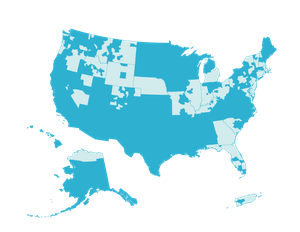LISC's CEO explains the how and why of the LISC Rural Promise, our organization-wide commitment to achieve 20 percent of our community development impact in rural America over the next three years.
The goal of the LISC Rural Promise is to lift our community development impact in rural communities to 20 percent of our entire impact by 2023. How will we measure that?
We track this impact data already, but we are refining the way we track it. We will hold up our numbers and measure how much change we effect in rural markets and how much in the urban market. It’s important to remember that this is not about diminishing our impact in urban markets, but about increasing it in rural ones, and making sure the number of housing units, jobs, facilities, etc. is proportional to the population and the demand in those places.
According to the USDA, just six to seven percent of philanthropic investment is dedicated to rural America, and overall U.S. investment is not nearly proportional to the population there. How can we appeal to funding partners to help us shift that trend?
The case to be made is in large part a business case, and a matter of common sense. Rural America is absolutely critical to a competitive America. Twenty percent of the population still lives in small towns and rural communities, and the assets there are incredible: from abundant, inexpensive land to the affordable cost of living to the work ethic of folks there and the sense of community. If we could really convince the country to make a major investment in, for instance, broadband infrastructure, the ability to do business there would dramatically expand.
We need to keep hammering these points home and continue to make that business case to philanthropy and the corporate sector. I am confident we can do that and inspire new partners to join us.
Where do you see the greatest opportunity for investment in rural America?
The most important is that of investing in people and their skill sets, to make sure people are prepared for the jobs of the 21st century. It used to be that people moved to where the jobs were, but now it’s just as common for jobs to move to where the talent is. The more we ensure that people in rural American are among the most prepared for today’s jobs, the more we will be able to attract employers to these communities. That goes for both employers coming from outside rural places, and those launching businesses from within.
What challenges to reaching our goal by 2023 do you foresee?
The challenge is going to be identifying a viable pipeline of projects to invest in to ensure we can meet that goal. So it’s really about being more aggressive in finding opportunities to make more New Markets equity investments, more grants, more loan capital investment, to find more partners to work with so we have the resources to do this. It’s the pipeline of opportunity that we'll have to nourish.
Another important challenge is making this an enterprise-wide commitment to rural impact. In fact, a crucial part of the goal is to bring all the parts or our organization into the Rural Promise, so that this family—LISC, NEF, New Markets Support Company and immito—is investing and prioritizing rural impact. This is about a cultural change for us as an organization. If in the next two to three years we can achieve that, the Rural Promise will be a huge success, whether or not we hit that 20 percent mark by 2023. Because if we embrace this as a company, we will hit that mark.

For many of us at LISC, the wellbeing of rural America resonates personally.
Absolutely. I am a son of the American rural South. It’s part of my story, and it was a transformative life experience. As the country becomes more and more urbanized, I want us to help make sure that other people have the opportunity to grow up and live and work in rural places, like the one that nurtured me, for generations to come.
What are your hopes and dreams for rural America in the next three years?
What I hope to see in our rural places is stronger infrastructure to actually accomplish community development projects. For example, right now, we have nearly 100 partners we collaborate with to get our work done. I would love to see that number double in three years, which means we would have another 100 partners with the capacity to carry out projects and programs.
I would like to see more funders investing in us to do our work, too, as well as more New Markets tax credits, more housing, more jobs created, more playing fields. Everything we do. My hope is that we can be successful in attracting more money that can be put to work in rural America. Every time I go to a rural place, I am struck by the talent that’s there. We have an obligation to make sure we're investing in that talent by catalyzing opportunity. After all, what’s good for rural is good for the whole country.

LISC CEO, Maurice A. Jones, shares the launch of the LISC Rural Promise, a commitment to elevate our impact in rural America by 20 percent over the next three years.
